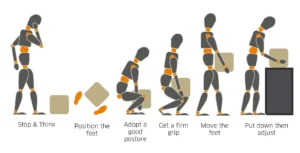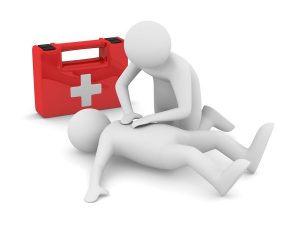 As workloads shift with the seasons, so do the risks we face. Now is a perfect time to reinforce safe manual handling practices and prevent musculoskeletal injuries across your team.
As workloads shift with the seasons, so do the risks we face. Now is a perfect time to reinforce safe manual handling practices and prevent musculoskeletal injuries across your team.
Whether you’re lifting, shifting, pushing, pulling, or simply standing for long hours—strains and sprains are the most common workplace injury in the UK. The good news? They’re also among the most preventable.
🤕 The Cost of “Just a Twinge”
We’ve all heard it: “It’s just a sore back—I’ll shake it off.” But injuries like:
Many of these injuries result from poor lifting techniques, rushing tasks, or using the wrong equipment.
🛠️ 5 Manual Handling Tips to Share with Your Team
📋 Don’t Forget: Employer & Employee Responsibilities
Under the Manual Handling Operations Regulations 1992, employers must:
Employees must:
✅ What Can You Do This Week?
👀 Remember: Good habits save backs, joints and time.
Small changes in how we lift, carry, and move can make a huge difference in injury prevention. Let’s keep sprains and strains off the sick list this summer.
Here is a toolbox talk to provide to staff – Click here Toolbox_Talk_Manual_Handling.
Contact us for further information.
April marks Stress Awareness Month a time dedicated to raising awareness about the causes and effects of stress, and more importantly, how we can take steps to manage it in our daily lives. Whether it stems from work pressures, personal challenges, or simply the fast pace of modern life, stress can take a serious toll on our wellbeing if left unchecked.
In this blog, I will be looking at the small changes we can make that will have a big difference on both our mental and physical health, and some practical strategies we can all use to reduce its effects both at work and at home.
Contact us for further information.
 WHY LACK OF SAFETY INDUCTION AND TRAININGS LEADS TO ACCIDENTS
WHY LACK OF SAFETY INDUCTION AND TRAININGS LEADS TO ACCIDENTS
Lack of Hazard Awareness
Without proper induction, workers may be completely unaware of the specific hazards present in their work environment.
This includes dangers related to machinery, chemicals, working at heights, and other potential risks.
Insufficient Knowledge of Safe Work Practices
Training provides essential knowledge of safe operating procedures, the correct use of personal protective equipment (PPE), and emergency response protocols.
Without this knowledge, workers are more likely to make errors that lead to accidents.
Failure to Recognize and Respond to Risks
Effective training teaches workers how to recognize potential hazards and how to take appropriate action to mitigate those risks. Lack of training leaves workers ill-equipped to handle unexpected situations.
Increased Risk of Human Error
Human error is a major contributing factor to accidents. However, proper training can significantly reduce the likelihood of errors by providing workers with the necessary skills and knowledge to perform their tasks safely.
Inadequate Emergency Preparedness
Safety induction and training include instruction on emergency procedures, such as evacuation plans and first aid. Without this training, workers may panic or make poor decisions in an emergency, exacerbating the situation.
Poor Safety Culture
When safety training is lacking, it creates a general poor safety culture. When workers and management do not prioritize safety, accidents are far more likely.
Super video to watch – Click Here
Any questions, please contact us.
 Do you know where your accident book is?
Do you know where your accident book is?
Accident books are a legal requirement.
More specifically, by law, every employer must record accidents to employees and visitors. Two key laws apply to accident reporting/recording at work:
Many people think that the accident book is a health and safety requirement. After all, accidents are a health and safety issue, and regulations that require the reporting of accidents (like RIDDOR) are health and safety regulations too.
So it might surprise you to find out that the law on accident books doesn’t come from a health and safety regulation. The SSCPR makes accident books a legal requirement for businesses employing 10 or more people.
So if you employ less than 10 people, you don’t legally need an accident book under the SSCPR. However, RIDDOR reporting is a legal requirement for businesses of any size, so it makes sense for every workplace to keep an accident book to comply with the law.
If an accident happens, the details of the accident and the injury should be recorded in the accident book.
Schedule 4 of the SSCPR lists the contents that should be entered into an accident book record as:
Accident book records must legally be kept for at least three years. However, it is good practice to keep them for at least 6 years in case of legal action.
The accident book, and any following investigation, can give a complete record of the accident should an insurance claim be made, and should also be seen as an opportunity to improve health and safety and prevent future accidents.
The accident book should be kept by the employer, but there are times when a record may need to be shared with others:
Most of the time, the details recorded in the accident book should be kept confidential and don’t need to be shared or reported to external services like the HSE. Things like minor accidents need to be investigated by the employer but don’t need to be recorded outside the organisation.
Contact us if you require further information.
Early August each year sees Cycle to Work Day, a national and international event encouraging staff to take to two wheels, or three for tricyclists, for 24-hours — and hopefully develop this low-carbon habit on many other work and leisure days.
Contact us if you have any queries.